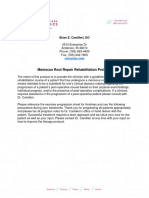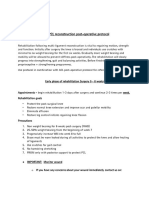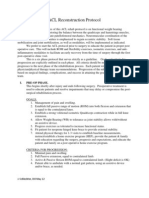Anterior Cruciate Ligament (ACL) Reconstruction Rehabilitation Protocol
Anterior Cruciate Ligament (ACL) Reconstruction Rehabilitation Protocol
Uploaded by
ukissirrorrCopyright:
Available Formats
Anterior Cruciate Ligament (ACL) Reconstruction Rehabilitation Protocol
Anterior Cruciate Ligament (ACL) Reconstruction Rehabilitation Protocol
Uploaded by
ukissirrorrOriginal Title
Copyright
Available Formats
Share this document
Did you find this document useful?
Is this content inappropriate?
Copyright:
Available Formats
Anterior Cruciate Ligament (ACL) Reconstruction Rehabilitation Protocol
Anterior Cruciate Ligament (ACL) Reconstruction Rehabilitation Protocol
Uploaded by
ukissirrorrCopyright:
Available Formats
Anterior Cruciate Ligament (ACL) Reconstruction Rehabilitation Protocol
Rehabilitation and Fitness Video ACL Reconstruction Surgical Video
General Considerations:
Progression should be based on careful monitoring of the patient's functional status. Early emphasis on achieving full hyperextension equal to the opposite side. Passive and active range of motion as tolerated. CPM may be used if ROM not progressing. Full weight bearing as soon as tolerated with no limp (unless otherwise indicated). Regular manual treatment should be conducted to the patella and all incisions. Controlled exercises can be performed without the use of the brace; post-op brace issued on individual basis. Exercises should focus on proper patella tracking and recruitment of the VMO. Early recruitment of the VMO using home electrical stimulation unit if necessary. No resisted leg extension machines (isotonic or isokinetic) at any point in the rehab process. Patient should be well aware that healing and tissue maturation continues to take place for one year after surgery. Patients are given a functional assessment/sport test at 3 months, 6 months, and 1 year post-op. Rationale for phases.
PHASE I (Approximately Weeks 1 - 2) - Max Protection Phase:
MD visit Day 1 post-op to change dressing and review home program. MD visit at 8 - 10 days for suture removal and check-up. Icing and elevation as much as able to minimize edema and promote healing. If needed, use of a CPM at home for 4 - 6 hours a day. Gait training to promote best quality of gait with the least amount of assistance. Passive and active range of motion exercises. Balance/proprioception exercises in a protected environment. Well-leg stationary cycling, upper body conditioning, and core conditioning. Soft tissue treatments to posterior musculature, quads, and infrapatellar pouch. Extensive patellar mobilizations, superior/inferior glides and patellar tipping.
***Passive range of motion should be 0 or hyperextension to 90 flexion, minimal pain and edema, and unassisted good, quality gait before moving onto Phase II.
PHASE II (Approximately Weeks 2 - 4) - Moderate Protection Phase:
MD visit at 4 weeks. Patient still needs to be somewhat restful with low impact on knee, must elevate and ice daily. Walking for exercise limited to 15 - 20 minutes per day if no swelling or limping. Continue with range of motion, gait training, soft tissue treatments and balance exercises. Incorporate functional exercises/eccentrics (i.e. squats, bridging, intense core training, and 2" step downs). Leg weight machines PREs (i.e. leg press, hamstring curls, calf raises, abduction/adduction). Aerobic exercises as tolerated (i.e. bilateral stationary cycling, UBE, Elliptical). Pool workouts including deep water running, waist-high fast walking in all directions. ***Range of motion should be equal, extension bilaterally to 120 flexion, normal gait without assist, single-leg balance ability, and no significant edema before moving to Phase III. CPM can be discontinued if ROM goals reached.
PHASE III (Approximately Weeks 4 - 6) - Return to Function/Strengthening Phase:
Continue any necessary soft tissue mobilization required. Emphasize self stretching of both lower extremities. Increase the intensity of functional exercises (i.e. progress cycling, okay for road cycling, increase resistance in exercises, up to 1 hour walking for exercise, add stairs, climber or VersaClimber, increase challenge of proprioceptive training and eccentric exercises (i.e. 4 - 6" step downs). All exercises still in a controlled environment. Greater emphasis on single-leg strength exercises such as leg press and single leg squats. ***Patients should have full hyperextension and 80 - 90% of full flexion, able to do 4" single-leg step down, and bike with minimal+ resistance for 20 - 30 minutes before moving to Phase IV.
PHASE IV - Approximately Weeks 6 - 10 - Progressive Activity Phase:
Add lateral training exercises (i.e. lateral lunges, lateral step-ups, step overs). Begin to incorporate sport-specific training (i.e. volleyball bumping, easy hiking, functional training exercises in ALL planes of motion). No cutting or pivoting. Focus on good, quality eccentric strength and continue to increase challenge and complexity of proprioceptive exercises. ***All activities should be pain free without swelling, descending stairs should be smooth and pain free, single-leg squatting for 30 seconds should be of good quality and pain free before moving to Phase V.
PHASE V - Approximately Weeks 10 - 16 - Training for Sport Phase:
MD visit at 3 months and functional test. Incorporate bilateral, low-level jumping exercises. Watch for compensatory patterns with take-offs or landings. Progress to running if able to demonstrate good mechanics and appropriate strength at 12 weeks. Add appropriate agility training with progressive complexity and challenge still cautious with cutting and pivoting. Patients should be weaned into a home program with exercises specific to their particular activity/sport; aggressive road cycling is encouraged. Fit for functional knee brace if requested by MD. ***Single-leg squat test for 1 minute must be at least 80% of uninvolved leg, moderate resistance biking for 30 minutes should be easily tolerated, patient should be confident with all ADL's and independent in an appropriate gym and outdoor training program before moving to Phase IV. Patient should be well educated on avoiding cutting sports. Conditioning should be emphasized in this phase rather than playing a sport.
PHASE VI (Approximately Months 6 - 12) - Return to Sport Phase:
MD visit and sport test. Progression of program of increasing intensity to return to sports, increasing plyometric training with appropriate progression and emphasis on form. Patient should be adequately informed of higher risk activities and instructed on appropriate training for safest progression to those specific activities such as skiing, basketball, and soccer. ***Patient must pass sport test and MD exam before being released to full athletics
Functional Test at 12 Weeks:
Comparison of involved and uninvolved leg in the following tests: Single-leg squat for 1 minute; comparison of repetitions achieved in 1 minute. Lateral Excursion Test: Patient to stand on test leg attempt to tap (touch toe only) as far out laterally as possible with opposite leg. Distance recorded and compared for 3 attempts on each side. Posterior Excursion Test: Same as above but with patient tapping toe posteriorly. Cariocas: Patient to demonstrate good, quality movement and control with speed cariocas over 40'. Lateral Leaps: Patient to leap laterally at speed touching markers set 3 - 4' apart for 1 minute with excellent control and form.
Sport Test at 6 Months and 1 Year:
to full speed cariocas over 40' with good control and form. Single-leg contralateral reach downs: Patient to stand on test leg, with contralateral hand to touch floor at test legs ankle. Repeat over 1 minute and compare number of successful touches to uninvolved side. Forward Leap: Patient to leap forward (striding) with alternating legs over 40' to see quality and willing of single leg push-off and landing. Lateral Leap with Resistance: Same test as 12 Week but with added resistance cord around waist in line with direction of leap.
At One Year:
Add test of single leg hop for distance; 3 hop trials per leg. Add Change of Direction Drill: Patient to begin running forward and on command, reverse direction to backwards run; on next command, turn and run right; on next command turn and run left, etc. for 1 minute. Evaluate quality and control of movement.
NOTE: All progressions are approximations and should be used as a guideline only. Progression will be based on individual patient presentation, which is assessed throughout the treatment process.
You might also like
- (MARLAW) (MWF 130 - 300) Collision Regulations (Group1)Document2 pages(MARLAW) (MWF 130 - 300) Collision Regulations (Group1)Mikhail Roy Dela Cruz100% (2)
- NRL Round 12-Post CourierDocument1 pageNRL Round 12-Post Courierjoanalcaraz50% (4)
- Brigham & Women's Hospital - Knee Rehabilitation PT ProtocolsDocument27 pagesBrigham & Women's Hospital - Knee Rehabilitation PT ProtocolsShrutiNo ratings yet
- Acl Reconstruction Rehab Protocol The Stone ClinicDocument2 pagesAcl Reconstruction Rehab Protocol The Stone ClinicFaiyaz KhanNo ratings yet
- Rehabilitation Protocol For Posterior Cruciate Ligament PCLRDocument7 pagesRehabilitation Protocol For Posterior Cruciate Ligament PCLRrahul sharmaNo ratings yet
- Rehabilitation Protocol For MeniscectomyDocument4 pagesRehabilitation Protocol For MeniscectomyDan Avramiuc100% (1)
- Rehabilitation Protocol For Achilles Tendon RepairDocument10 pagesRehabilitation Protocol For Achilles Tendon Repairckpravin7754No ratings yet
- Total Knee Replacement Rehabilitation Protocol: General ConsiderationsDocument1 pageTotal Knee Replacement Rehabilitation Protocol: General ConsiderationsukissirrorrNo ratings yet
- Arthroscopic Rotator Cuff Repair Protocol:: Peter J. Millett, MD, MSCDocument4 pagesArthroscopic Rotator Cuff Repair Protocol:: Peter J. Millett, MD, MSCPhooi Yee LauNo ratings yet
- PATELLAR DISLOCATION - ACCELERATED r1Document3 pagesPATELLAR DISLOCATION - ACCELERATED r1fnproject.idNo ratings yet
- Rehabilitation Protocol For Brostrom RepairDocument4 pagesRehabilitation Protocol For Brostrom RepairHY Wong Orthopaedic Surgery SDN. BHD.No ratings yet
- Antonio Bosheski Barcelona Innovation Hub Return To PlayDocument10 pagesAntonio Bosheski Barcelona Innovation Hub Return To PlayAntonio BosheskiNo ratings yet
- Rehabilitation Protocol For ACLDocument9 pagesRehabilitation Protocol For ACLgb tradeNo ratings yet
- Meniscus Root Repair Rehab ProtocolDocument7 pagesMeniscus Root Repair Rehab Protocolcristianmaftei812No ratings yet
- acl rehab 1Document10 pagesacl rehab 1Soumya MukherjeeNo ratings yet
- Total Hip Arthroplasty PDFDocument10 pagesTotal Hip Arthroplasty PDFWindy ZeniccNo ratings yet
- Anterior Cruciate Ligament (Acl) ReconstructionDocument9 pagesAnterior Cruciate Ligament (Acl) ReconstructionMuhammad Hidayat ShafieNo ratings yet
- ACL Reconstruction: Patellar Tendon Graft/Hamstring Tendon GraftDocument6 pagesACL Reconstruction: Patellar Tendon Graft/Hamstring Tendon GraftArun TamilvananNo ratings yet
- Total Hip Replacement ProtocolDocument3 pagesTotal Hip Replacement ProtocolRezaul KarimNo ratings yet
- Anterior Cruciate Ligament Reconstruction Rehabilitation ProtocolDocument5 pagesAnterior Cruciate Ligament Reconstruction Rehabilitation ProtocolOmid MarjomakiNo ratings yet
- patellar-dislocation-non-operative-rehab-protocolDocument3 pagespatellar-dislocation-non-operative-rehab-protocolHEENA GHANSHYAM SOLANKINo ratings yet
- Rehabilitation Protocol For Meniscus RepairDocument16 pagesRehabilitation Protocol For Meniscus RepairAnonymous ecI8GUbaNo ratings yet
- Acl Accelerated ProtocolDocument6 pagesAcl Accelerated ProtocolkapsicumadNo ratings yet
- MPFL Protocol 14Document5 pagesMPFL Protocol 14diskraNo ratings yet
- MedialPatellofemoralLigamentReconstructionDocument6 pagesMedialPatellofemoralLigamentReconstructionJoe ANo ratings yet
- Achilles RepairDocument2 pagesAchilles RepairIoana HarpaNo ratings yet
- Arthroscopic Shoulder Anterior Stabilisation Rehabilitation Protocol by TENDAYI MUTSOPOTSI MSc. ORTHO-MEDDocument8 pagesArthroscopic Shoulder Anterior Stabilisation Rehabilitation Protocol by TENDAYI MUTSOPOTSI MSc. ORTHO-MEDPhysiotherapy Care SpecialistsNo ratings yet
- Weightbearing Status: Phase I (Days 1-7)Document6 pagesWeightbearing Status: Phase I (Days 1-7)Hoshmand J.AhmedNo ratings yet
- Orthopedic in PT PT ProtocolDocument23 pagesOrthopedic in PT PT ProtocoldrhalwagyNo ratings yet
- Knee-multi-lig-MBerginDocument5 pagesKnee-multi-lig-MBergininfancy14No ratings yet
- Spine - Lumbar DicsectomyDocument4 pagesSpine - Lumbar DicsectomyMuhammad Hidayat ShafieNo ratings yet
- Protocol 1 Achilles Tendon Repair v5Document2 pagesProtocol 1 Achilles Tendon Repair v5Carlos Martín De RosasNo ratings yet
- ACLPCLDocument11 pagesACLPCLmohamedhelalptNo ratings yet
- MPFL Reconstruction ProtocolDocument8 pagesMPFL Reconstruction ProtocolOana ApostoiuNo ratings yet
- Reverse Total Shoulder ArthroplastyDocument3 pagesReverse Total Shoulder ArthroplastyTiberiu BondreaNo ratings yet
- Physical Therapy Intervention in StrokeDocument42 pagesPhysical Therapy Intervention in Strokeinfo.etc.pkNo ratings yet
- Slap Lesion Repair Rehabilitation ProtocolDocument5 pagesSlap Lesion Repair Rehabilitation ProtocolNadine RomeroNo ratings yet
- ACL ReconstructionDocument4 pagesACL Reconstructionredbull227No ratings yet
- Rehabilitation Protocol For Knee ReplacementDocument2 pagesRehabilitation Protocol For Knee ReplacementShaun TylerNo ratings yet
- Physio Protocol Anterior Shoulder Dislocation NEW ADD 1Document2 pagesPhysio Protocol Anterior Shoulder Dislocation NEW ADD 1Abner SánchezNo ratings yet
- Thieken - Knee - ACL Reconstruction Rehab Protocol PDFDocument4 pagesThieken - Knee - ACL Reconstruction Rehab Protocol PDFEr Rajesh BuraNo ratings yet
- Rehabilitation Protocol For Ankle SprainDocument3 pagesRehabilitation Protocol For Ankle Sprainmanu gonzalezNo ratings yet
- Knee Meniscus Repair 2008Document5 pagesKnee Meniscus Repair 2008drrajmptnNo ratings yet
- Total Knee Replacement (TKR) : Rehabilitation: General ConsiderationsDocument3 pagesTotal Knee Replacement (TKR) : Rehabilitation: General ConsiderationsSuwendri KotoNo ratings yet
- Ant Shoulder DislocationDocument3 pagesAnt Shoulder DislocationÉva KappéterNo ratings yet
- Reverse TsaDocument4 pagesReverse Tsaprwill00No ratings yet
- Achilles Tendon RepairDocument2 pagesAchilles Tendon RepairmdelpPTNo ratings yet
- Rehabilitation Protocol For Acromioclavicular Joint ReconstructionDocument3 pagesRehabilitation Protocol For Acromioclavicular Joint ReconstructionGeorge MagarakisNo ratings yet
- Rehabilitation For Meniscus RepairDocument9 pagesRehabilitation For Meniscus RepairJosephine Saesaria100% (1)
- LumbarlaminectomyDocument4 pagesLumbarlaminectomyViral ShahNo ratings yet
- Holthusen Calcaneus Fracture ORIF Protocol 7.5.23Document3 pagesHolthusen Calcaneus Fracture ORIF Protocol 7.5.23İpek OMURNo ratings yet
- MPFL PDFDocument12 pagesMPFL PDFFydananda NPNo ratings yet
- Shoulder Instability - Just - OperativeDocument30 pagesShoulder Instability - Just - Operative3mkq4isiNo ratings yet
- Post Operative Management - TKRDocument31 pagesPost Operative Management - TKRselva5252No ratings yet
- ACL Rehab by Mike ReinoldDocument8 pagesACL Rehab by Mike Reinoldz_dechant100% (1)
- R CR ProtocolDocument4 pagesR CR Protocolalz388508No ratings yet
- Lumbar Discectomy Physical Therapy PrescriptionDocument3 pagesLumbar Discectomy Physical Therapy PrescriptionFisioterapi UnaicNo ratings yet
- Meniscus Injury: Khairul Nizam Abdul Rahman 4262143008Document22 pagesMeniscus Injury: Khairul Nizam Abdul Rahman 4262143008Soumashree MondalNo ratings yet
- Brigham & Women's Hospital - Return To Sports GuidelinesDocument17 pagesBrigham & Women's Hospital - Return To Sports GuidelinesShruti100% (1)
- Acl Reconstruction ProtocolDocument8 pagesAcl Reconstruction ProtocolMestereaga AlinNo ratings yet
- Simplified Strength Training using your Bodyweight and a Towel at Home Vol. 1: Legs/Quads: VolFrom EverandSimplified Strength Training using your Bodyweight and a Towel at Home Vol. 1: Legs/Quads: VolNo ratings yet
- Skolik 1Document10 pagesSkolik 1api-519861342No ratings yet
- 1 - Penn National RETROSPECTODocument8 pages1 - Penn National RETROSPECTOjesus martinezNo ratings yet
- 6A Leo Wang 2nd Draft 2023.1.9Document2 pages6A Leo Wang 2nd Draft 2023.1.9Leo WangNo ratings yet
- MASS Vol 2 Issue 7 PDFDocument92 pagesMASS Vol 2 Issue 7 PDFAndra SpatarNo ratings yet
- Seine Nets ModuleDocument12 pagesSeine Nets ModuleJerick Christian P DagdaganNo ratings yet
- Bio Group (12th)Document9 pagesBio Group (12th)pandeyakriti1978No ratings yet
- Wills Wing - Sport 2 - 155 ManualDocument69 pagesWills Wing - Sport 2 - 155 ManuallechuNo ratings yet
- U1 Level1Document2 pagesU1 Level1andrea.bergada83No ratings yet
- Amigos para SiempreDocument3 pagesAmigos para Siempreprofsusanasi260No ratings yet
- Chapter 1: History and Background of ArnisDocument6 pagesChapter 1: History and Background of ArnisGlen BeloNo ratings yet
- Player Form 2012-2013 - Mini World CupDocument1 pagePlayer Form 2012-2013 - Mini World CupWoolgoolga United Football ClubNo ratings yet
- Intro Basic Afl RulesDocument1 pageIntro Basic Afl Rulesapi-431813813No ratings yet
- Whoqol ManualDocument21 pagesWhoqol ManualelvineNo ratings yet
- COLLEGE ESPORTS - What You Need To Know PDFDocument160 pagesCOLLEGE ESPORTS - What You Need To Know PDFxolilevNo ratings yet
- 02KET Prac Exam 1 ListenDocument6 pages02KET Prac Exam 1 ListenfmarouanNo ratings yet
- Sample ResolutionDocument2 pagesSample ResolutionsangguniangNo ratings yet
- Study Guide P2Document2 pagesStudy Guide P2Aquia M. BrandinoNo ratings yet
- Sport British English TeacherDocument8 pagesSport British English TeacherBhebs Dador0% (1)
- Nova Verzija Knjige Elementary Business EnglishDocument101 pagesNova Verzija Knjige Elementary Business EnglishMladen LičinaNo ratings yet
- Unit3 All WorksheetsDocument9 pagesUnit3 All WorksheetsNikNejmNo ratings yet
- RES Horse Show Full Results Bermuda October 25, 2022Document9 pagesRES Horse Show Full Results Bermuda October 25, 2022BernewsAdminNo ratings yet
- Formula One - Sporting Regulations - 2017Document74 pagesFormula One - Sporting Regulations - 2017David LusignanNo ratings yet
- Analysis of Adventure Tourism in Nepal FinalDocument16 pagesAnalysis of Adventure Tourism in Nepal FinalAnonymous G5ScwBNo ratings yet
- IPL Schedule 2014: Date Local GMT MatchDocument4 pagesIPL Schedule 2014: Date Local GMT MatchRavi Singh BishtNo ratings yet
- Fingerhut EL00239Document2 pagesFingerhut EL00239gershon_daveNo ratings yet
- Edrm 600 Research PaperDocument16 pagesEdrm 600 Research Paperapi-334387919No ratings yet
- Pengaruh Kualitas Produk, Citra Merek, Harga Dan Promosi Terhadap Keputusan Pembelian Mobil Jenis MPV Merek Toyota Kijang Innova Di SemarangDocument10 pagesPengaruh Kualitas Produk, Citra Merek, Harga Dan Promosi Terhadap Keputusan Pembelian Mobil Jenis MPV Merek Toyota Kijang Innova Di SemarangtriNo ratings yet
- 4 U1 Grammar - Modification With Adjectives 1 - Modo - Informe - Unit 1 - Lesson 2 - Bootcamp A2 (Pro) - MyEnglishLabDocument2 pages4 U1 Grammar - Modification With Adjectives 1 - Modo - Informe - Unit 1 - Lesson 2 - Bootcamp A2 (Pro) - MyEnglishLabTrinidad CedeñoNo ratings yet

























































































